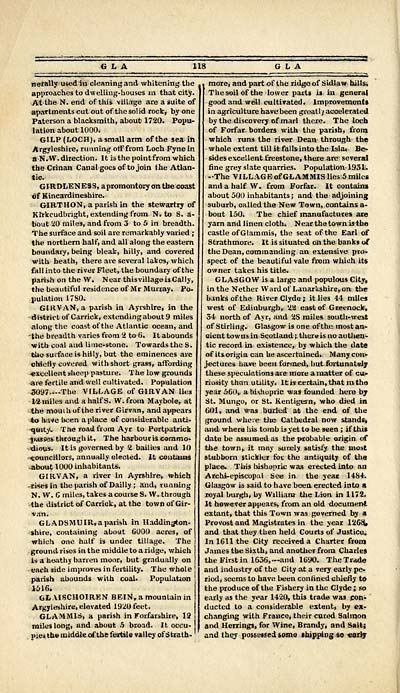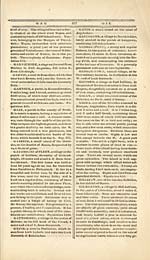Gazetteer of Scotland
(120) Page 118 - GIL
Download files
Complete book:
Individual page:
Thumbnail gallery: Grid view | List view

GLA X
nerally used in cleaning and whitening the
approaches to dwelling-houses in that city.
At the N. end of this village are a suite of
apartments cut out of the solid rock, by one
Paterson a blacksmith, about 1720. Popu-
lation about 1000.
GILP (LOCH), asmall arm of the sea in
Argylesbire, running off from Loch Fyne in
a N. W. direction. It is the pointfrom which
theCrinan Canal goes of to join the Atlan-
tic.
G1RDLENESS, apromontory on the coast
<jf Kincardineshire.
GIRTHON, a parish in the stewartry of
Kirkcudbright, extending from N. to S. a-
bout 20 miles, and from 3 to 5 in breadth.
The surface and soil are remarkably varied ;
the northern half, and all along the eastern
boundary, being bleak, hilly, and covered
with heath, there are several lakes, which
fall into the river Fleet, the boundary of the
parish on the W. Near thisvillageisCally,
the beautiful residence of Mr Murray. Po-
pulation 1780.
GIKVAN.a parish in Ayrshire, in the
district of Carrick, extending about 9 miles
along the coast of the Atlantic ocean, and
the breadth varies from 2 to 6. It abounds
with coal and lime-stone. TowardstheS.
the surface is hilly, but the eminences are
chiefly covered with short grass, affording
■excellent sheep pasture. The low grounds
are fertile and well cultivated. Population
3097— The VILLAGE of GIRVAN lies
12 miles and a half S. W.frotn Maybole, at
the mouili of the river Girvan, and appears
*o have been a place of considerable anti-
-qAity. The road from Ayr to Portpatrick
jpassos through it. The harbouris commo-
dious. It is governed by 2 bailies and 10
councillors, annually elected. It contains
about 1000 inhabitants.
GIRVAN, a river in Ayrshire, which
rises in the parish of Dailly; and, running
N . W. C miles, takes a course S. W. through
the district of Carrick, at the town of Gir-
GLADSMUIR, a parish in Haddinjfton-
shire, containing about G00O acres, of
which one half is under tillage. The
ground vises in the middle to a ridge, which
is a heathy barren moor, but gradually on
each side improves in fertility. The whole
parish abounds with coal. Population
1616*
GIi.VISCHOIREN BElN, a mountain in
Argyleshire, elevated 1920 feet.
GLAMMIS, a parish in Forfarshire, 12
miles long, and about 9 broad. It occu-
pies the middle of the fertile valley of Strath-
GLA
more, and part of the ridge of Sidlaw hills.
The soil of the lower parts is in general
good and well cultivated. Improvements
in agriculture have been greatly accelerated
by the discovery of marl there. The loch
of Forfar, borders with the parish, from
which runs the river Dean through the
whole extent till it falls into the Isla. Be>
sides excellent freestone, there are severed
fine grey slate quarries. Population- 1931.
-The VILLAGE of GiAMMIS lies 5 miles
and a half VV. from Forfar. It contains
about 500 inhabitants ; and the adjoining
suburb, oalledthe New Town, contains a-
bout 150. The chief manufactures are
yarn and linen cloth. Near the town is the
castle of Glammis, the seat of the Earl of
Strathmore. It is situated on the banks of
the Dean, commanding an extensive pro-
spect of the beautiful vale from which its
owner takes his title.
GLASGOW is a large and populous City,
in the Nether Ward of Lanarkshire, on the
hanks of the River Clyde ; it lies 44 miles
west of Edinburgh, 22 east of Greenock,
34 north of Ayr, and 2S miles south-west
of Stirling. Glasgow is one of the most an-
cient towns in Scotland ; there is no authen-
tic record in existence, by which the date
of itsorigin can be ascertained. Many con-
jectures have been formed, but fortunately
these speculations are more a matter of cu-
riosity than utility. It is certain, that m tha
year 560„ a bishopric was founded here by
St. Mungo, or St. Kentigern, who died in
601, and was burled at the end of the
ground where the Cathedral now stands,
and whera his tomb isyetto be seen ; if this
date be assumed as the probable origin of
the town,, it may surely satisfy the most
stubborn stickler fbi the antiquity of tha
place. This bishopric was erected into an
Archi-episcopal See in the yeai 1484.
Glasgow is said to have been, erected into a
royal burgh, by William the Lion in 1172.
It however appears, from an old document
extant, that this Town was governed by a
Provost and Magistrates in the year 126£i,
and that they then held Courts of Justice.
In 1611 the City received a Charter from
James the Sixth, and another from Charles
the First in 1636,— and 1690. The Trade
and industry of the City at a very early pe-
riod, seems to have been confined chiefly to
the produce of the Fishery in the Clyde ; so
early as the year 1420, this trade was con-
ductcd to a considerable extent, by ex-
changing with France* their cared Salmon
and Herrings, for Wine, Brandy, and Saltj
and they possessed some shipping so early
nerally used in cleaning and whitening the
approaches to dwelling-houses in that city.
At the N. end of this village are a suite of
apartments cut out of the solid rock, by one
Paterson a blacksmith, about 1720. Popu-
lation about 1000.
GILP (LOCH), asmall arm of the sea in
Argylesbire, running off from Loch Fyne in
a N. W. direction. It is the pointfrom which
theCrinan Canal goes of to join the Atlan-
tic.
G1RDLENESS, apromontory on the coast
<jf Kincardineshire.
GIRTHON, a parish in the stewartry of
Kirkcudbright, extending from N. to S. a-
bout 20 miles, and from 3 to 5 in breadth.
The surface and soil are remarkably varied ;
the northern half, and all along the eastern
boundary, being bleak, hilly, and covered
with heath, there are several lakes, which
fall into the river Fleet, the boundary of the
parish on the W. Near thisvillageisCally,
the beautiful residence of Mr Murray. Po-
pulation 1780.
GIKVAN.a parish in Ayrshire, in the
district of Carrick, extending about 9 miles
along the coast of the Atlantic ocean, and
the breadth varies from 2 to 6. It abounds
with coal and lime-stone. TowardstheS.
the surface is hilly, but the eminences are
chiefly covered with short grass, affording
■excellent sheep pasture. The low grounds
are fertile and well cultivated. Population
3097— The VILLAGE of GIRVAN lies
12 miles and a half S. W.frotn Maybole, at
the mouili of the river Girvan, and appears
*o have been a place of considerable anti-
-qAity. The road from Ayr to Portpatrick
jpassos through it. The harbouris commo-
dious. It is governed by 2 bailies and 10
councillors, annually elected. It contains
about 1000 inhabitants.
GIRVAN, a river in Ayrshire, which
rises in the parish of Dailly; and, running
N . W. C miles, takes a course S. W. through
the district of Carrick, at the town of Gir-
GLADSMUIR, a parish in Haddinjfton-
shire, containing about G00O acres, of
which one half is under tillage. The
ground vises in the middle to a ridge, which
is a heathy barren moor, but gradually on
each side improves in fertility. The whole
parish abounds with coal. Population
1616*
GIi.VISCHOIREN BElN, a mountain in
Argyleshire, elevated 1920 feet.
GLAMMIS, a parish in Forfarshire, 12
miles long, and about 9 broad. It occu-
pies the middle of the fertile valley of Strath-
GLA
more, and part of the ridge of Sidlaw hills.
The soil of the lower parts is in general
good and well cultivated. Improvements
in agriculture have been greatly accelerated
by the discovery of marl there. The loch
of Forfar, borders with the parish, from
which runs the river Dean through the
whole extent till it falls into the Isla. Be>
sides excellent freestone, there are severed
fine grey slate quarries. Population- 1931.
-The VILLAGE of GiAMMIS lies 5 miles
and a half VV. from Forfar. It contains
about 500 inhabitants ; and the adjoining
suburb, oalledthe New Town, contains a-
bout 150. The chief manufactures are
yarn and linen cloth. Near the town is the
castle of Glammis, the seat of the Earl of
Strathmore. It is situated on the banks of
the Dean, commanding an extensive pro-
spect of the beautiful vale from which its
owner takes his title.
GLASGOW is a large and populous City,
in the Nether Ward of Lanarkshire, on the
hanks of the River Clyde ; it lies 44 miles
west of Edinburgh, 22 east of Greenock,
34 north of Ayr, and 2S miles south-west
of Stirling. Glasgow is one of the most an-
cient towns in Scotland ; there is no authen-
tic record in existence, by which the date
of itsorigin can be ascertained. Many con-
jectures have been formed, but fortunately
these speculations are more a matter of cu-
riosity than utility. It is certain, that m tha
year 560„ a bishopric was founded here by
St. Mungo, or St. Kentigern, who died in
601, and was burled at the end of the
ground where the Cathedral now stands,
and whera his tomb isyetto be seen ; if this
date be assumed as the probable origin of
the town,, it may surely satisfy the most
stubborn stickler fbi the antiquity of tha
place. This bishopric was erected into an
Archi-episcopal See in the yeai 1484.
Glasgow is said to have been, erected into a
royal burgh, by William the Lion in 1172.
It however appears, from an old document
extant, that this Town was governed by a
Provost and Magistrates in the year 126£i,
and that they then held Courts of Justice.
In 1611 the City received a Charter from
James the Sixth, and another from Charles
the First in 1636,— and 1690. The Trade
and industry of the City at a very early pe-
riod, seems to have been confined chiefly to
the produce of the Fishery in the Clyde ; so
early as the year 1420, this trade was con-
ductcd to a considerable extent, by ex-
changing with France* their cared Salmon
and Herrings, for Wine, Brandy, and Saltj
and they possessed some shipping so early
Set display mode to: Large image | Transcription
Images and transcriptions on this page, including medium image downloads, may be used under the Creative Commons Attribution 4.0 International Licence unless otherwise stated. ![]()
| Gazetteers of Scotland, 1803-1901 > Gazetteer of Scotland > (120) Page 118 - GIL |
|---|
| Permanent URL | https://digital.nls.uk/97423134 |
|---|

